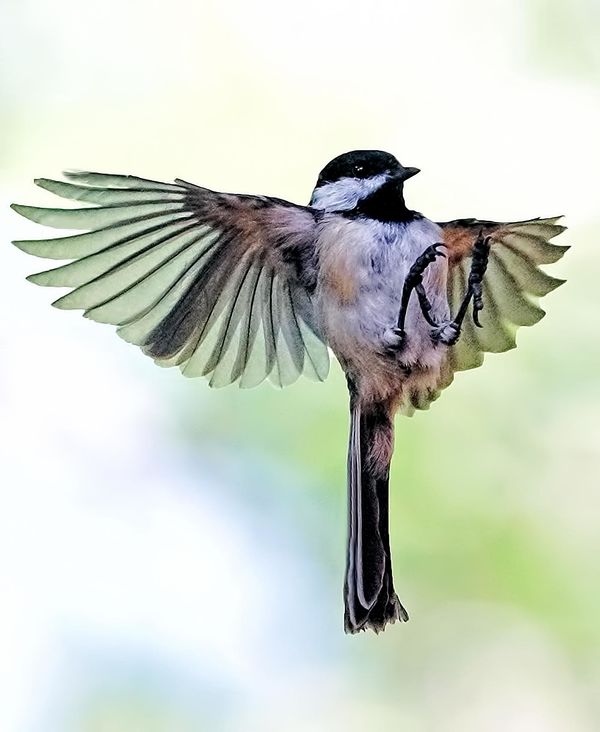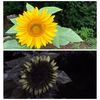Auto ISO
Feb 1, 2019 23:10:03 #
ronpier wrote:
I have similar issues and am converting to faster ff lenses with fixed apertures of 1.8,2.8 and f4. This allows me to shoot with faster shutter speeds. Keeping ISO under control with faster lenses also helps to keep down noise. I plan to finish the conversion by later this year or early next year with the full range from 17mm to 210mm, f1.8,2.8 or f4 max. apertures and able to be used on all of my cameras now and future except for the Coolpix.
Actually, I have found using auto ISO to be most beneficial, not when I needed a wider aperture but when I want to make sure I have adequate depth of field (dof) for my subject and adequate shutter speed to stop the action, especially in unknown situations like when I don't know how much shutter speed is going to be required to stop the action.
For instance, in the shot posted below, I didn't know what shutter speed it would take to stop the chickadee or precisely the width dof I needed so I opted for f/8 and 1/4000 which is the max shutter speed on the camera I was using, a Sony a6000 with a Canon EF70-200mm f/2.8L IS II adapted. Reaction time was short, as it always is with a chickadee so I let the ISO float with a 100 min and a 6400 max. As it turned out, the a6000 needed all that and more because those settings gave me an image that was underexposed and noisy which I had to adjust in post. I could have used more shutter speed or more ISO or both to get a cleaner shot which might not have been all that much cleaner if the ISO was pushed on up higher but I can't be sure about that. f/5.6 might have given me an adequate dof but I didn't know that in advance.
Next time I shoot chickadees, if there is one, I'll vary aperture to see if I can drop the ISO but there's no wiggle room for increased shutter speed when it's already maxed out. I'm pretty sure that I would not want to blow a rare chance to get acceptable shots by shooting with a wide open aperture since it's impossible to tell in advance what the dof minimum needs to be to capture the entire wingspan although it's only a few inches. My point is that going into an unknown situation, we often need to give ourselves all the leeway we can to get the shot we're after, and to do so consistently, not just a one-off fluke. Chickadees don't always fly in the same place. I will admit that I tricked them into flying generally where I wanted them to but even then, it's uncertain that they'll stay in a path only a few inches wide which would let you justify wider apertures on a more expensive lens. I had way more aperture but wasn't able to use it.
I don't know what you want to shoot but I find that much of the time I cannot get a whole big animal like an elk or moose clearly within the dof when shooting at wide open aperture. Of course, there are times... Most of us won't make a career out of shooting small, super fast birds in flight but what I've experienced is that the bigger the animal, the less likely you'll get the whole thing in focus with a wide aperture and it may require you to stop down some, let the ISO float up, and deal with the noise in post processing. Of course, each case is different and choosing settings liberally and letting ISO float up some may be your best option in some cases.
For all you folks who've seen the image below, please forgive me for posting it again but it just happens to demonstrate the point I'm making about how faster more expensive lens were of no benefit in this case.

Feb 1, 2019 23:43:36 #
gessman wrote:
Actually, I have found using auto ISO to be most b... (show quote)
I had one the other day, Auto ISO set at 1600, min shutter speed 1/60. Shooting low light f2.8. Auto ISO maxed out at 1600 and camera dropped shutter speed to 1/25 in order to create the image. Looking back I should have set Auto ISO at 3200 to keep faster shutter speed. Image was OK hand held at 1/25 but would have been sharper at 1/50 or 1/60.
Feb 2, 2019 00:02:22 #
MW wrote:
Most of the time. I’m using a Fuji X-E3. After some experimentation I observed that it nearly always selected the ISO that I would have selected manually. Except it never
forgets and I sometimes do.
forgets and I sometimes do.
Exactly!! That's why this method works so well in so many situations.
Feb 2, 2019 00:12:44 #
ronpier wrote:
I had one the other day, Auto ISO set at 1600, min shutter speed 1/60. Shooting low light f2.8. Auto ISO maxed out at 1600 and camera dropped shutter speed to 1/25 in order to create the image. Looking back I should have set Auto ISO at 3200 to keep faster shutter speed. Image was OK hand held at 1/25 but would have been sharper at 1/50 or 1/60.
I hear you and everyone has to set their own limits but I hear that Topaz's new AI Clear does a fantastic job of clearing up noise so I'm going to move my upper limit on up three more notches, figuring if the camera selects the lowest ISO it can given the other settings, if I shoot something where ISO goes on up to 51,200 and I get the shot but can't calm the noise down, I can always discard it but to not get the shot in the first place would make it seem to be a waste of time even going out to shoot. I might get lucky and only have to deal with noise from a 12,800 ISO shot and be able to deal with just fine. The tech of all this is improving with each passing day and what we can't do with a high ISO image today may have a remedy two years from now and with storage being dirt cheap, it wouldn't cost much to hang onto a few shots that otherwise beyond noise would make nice keepers.
Feb 2, 2019 00:42:38 #
gessman wrote:
I hear you and everyone has to set their own limit... (show quote)
While I need and should relook at what my maximum acceptable ISO limits are I don’t know if 51,200 or higher can be brought back from the dead with acceptable results.
Feb 2, 2019 08:30:45 #
ronpier wrote:
While I need and should relook at what my maximum acceptable ISO limits are I don’t know if 51,200 or higher can be brought back from the dead with acceptable results.
Depending on the camera, actually it can. It may require a conversion to b/w tho.
Feb 2, 2019 12:09:09 #
jackm1943 wrote:
Depending on the camera, actually it can. It may require a conversion to b/w tho.
At that point I think the dead should be buried. Hit delete and move on.
Feb 2, 2019 14:03:54 #
ronpier wrote:
At that point I think the dead should be buried. Hit delete and move on.
Well, things are changing at a rapid rate, cameras getting better, post processing software is getting better at fixing problems but we have to buy in to take advantage of those changes. We can't get locked in and try to hold back the tide - we have to keep moving or get left behind, experiment and adjust and if what you have won't do what you want, get what will. It's a rat race but like everything else in a progressive world, you get to choose your jumping off place.
Feb 2, 2019 15:13:45 #
gessman wrote:
Well, things are changing at a rapid rate, cameras getting better, post processing software is getting better at fixing problems but we have to buy in to take advantage of those changes. We can't get locked in and try to hold back the tide - we have to keep moving or get left behind, experiment and adjust and if what you have won't do what you want, get what will. It's a rat race but like everything else in a progressive world, you get to choose your jumping off place.
Sometime in the future you can always shoot at base ISO. If underexposed simply crank it up in post. It would have the same effect as raising the ISO (that is more noise) we also lose 1 bit for every stop but it may not matter if the RAW file is 24 or 32 bit instead of 14 bit like now.
Feb 2, 2019 23:08:30 #
gessman wrote:
Well, things are changing at a rapid rate, cameras getting better, post processing software is getting better at fixing problems but we have to buy in to take advantage of those changes. We can't get locked in and try to hold back the tide - we have to keep moving or get left behind, experiment and adjust and if what you have won't do what you want, get what will. It's a rat race but like everything else in a progressive world, you get to choose your jumping off place.
I had a college professor many years ago in one of my business classes stress ”One needs to change in order to remain the same.”
Feb 3, 2019 11:11:21 #
ronpier wrote:
I had a college professor many years ago in one of my business classes stress ”One needs to change in order to remain the same.”
Interesting. I once had someone explain the exact same concept to me at my Summer job on the floor of a very blue-collar glass factory. It seems wisdom is wherever you find it.
Feb 3, 2019 23:29:01 #
Salo wrote:
Interesting. I once had someone explain the exact same concept to me at my Summer job on the floor of a very blue-collar glass factory. It seems wisdom is wherever you find it.
Having been in business for the past 35 years has thought me that in order to remain successful a business needs to change as often as required depending on customer demand. Look at business models that did not change-i.e. Sears, Montgomery Ward, General Motors etc. The last one exists only because of the American Taxpayer and hopefully will continue to be around for a long time but only if it changes with market demands this time around. We have and are seeing huge changes in the photography market and only those with an up to date business model will survive.
Feb 4, 2019 09:30:24 #
srt101fan wrote:
Thanks for posting!... You might be interested in these recent UHH topics that address Auto ISO:
https://www.uglyhedgehog.com/t-574374-1.html (Situations Where Aperture-priority or Shutter-priority Work better than manual or Auto ISO + Manual + EC)
https://www.uglyhedgehog.com/t-573649-1.html (Myth:- M + Auto ISO isn't manual.)
https://www.uglyhedgehog.com/t-572707-1.html (“Manual + Auto ISO”; is it the best shooting mode for beginners who want to go beyond full Auto?)
https://www.uglyhedgehog.com/t-574374-1.html (Situations Where Aperture-priority or Shutter-priority Work better than manual or Auto ISO + Manual + EC)
https://www.uglyhedgehog.com/t-573649-1.html (Myth:- M + Auto ISO isn't manual.)
https://www.uglyhedgehog.com/t-572707-1.html (“Manual + Auto ISO”; is it the best shooting mode for beginners who want to go beyond full Auto?)
Feb 4, 2019 10:21:23 #
If you want to reply, then register here. Registration is free and your account is created instantly, so you can post right away.





